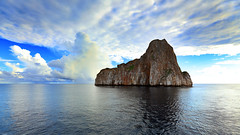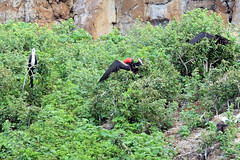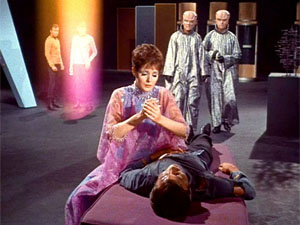Isla San Cristóbal to Guayaquil. Tuesday, 19 April, 2011
 This morning was an early start, after another cruise during the night to the island of San Cristóbal. We assembled at 06:00 on the top sun deck of the boat for a view of the approaching Léon Dormido (also known as Kicker Rock) – a volcanic lava cone now exposed as a bare chunk of rock jutting from the sea several hundred metres off the shore of the main island. The aim here was to do a couple of circuits of the rock to observe the nesting and courtship display of frigatebirds.
This morning was an early start, after another cruise during the night to the island of San Cristóbal. We assembled at 06:00 on the top sun deck of the boat for a view of the approaching Léon Dormido (also known as Kicker Rock) – a volcanic lava cone now exposed as a bare chunk of rock jutting from the sea several hundred metres off the shore of the main island. The aim here was to do a couple of circuits of the rock to observe the nesting and courtship display of frigatebirds.
 The rock is split by a narrow channel of water, otherwise presenting a steeply sloping profile that gives it its Spanish name of “sleeping lion”. There are only a few alcoves where a sea lion can haul out of the water, and these were populated by dozing beasts. We also saw lots of blue-footed boobies nesting or streaking the rock with guano. But the major attractions here were the magnificent frigatebirds, which nest on the rock. As the boat did a circuit, we could see several nests with birds on them, and as we watched the males inflated their large red throat sacs in their spectacular courtship display. They were necessarily one or two hundred metres away, but we got good views through binoculars or telephoto camera lenses.
The rock is split by a narrow channel of water, otherwise presenting a steeply sloping profile that gives it its Spanish name of “sleeping lion”. There are only a few alcoves where a sea lion can haul out of the water, and these were populated by dozing beasts. We also saw lots of blue-footed boobies nesting or streaking the rock with guano. But the major attractions here were the magnificent frigatebirds, which nest on the rock. As the boat did a circuit, we could see several nests with birds on them, and as we watched the males inflated their large red throat sacs in their spectacular courtship display. They were necessarily one or two hundred metres away, but we got good views through binoculars or telephoto camera lenses.
The boat circled the rock twice, allowing us plenty of time to see the various birds. We also spotted a Pacific green sea turtle in the water at the base of the rock, watching it surface to breathe a few times before it disappeared again. Having completed our circuits of the rock, the boat set out for the small town of Puerto Baquerizo Moreno, the capital of the Galapagos province of Ecuador, on the southwest coast of San Cristóbal.
(more…)








 “
“